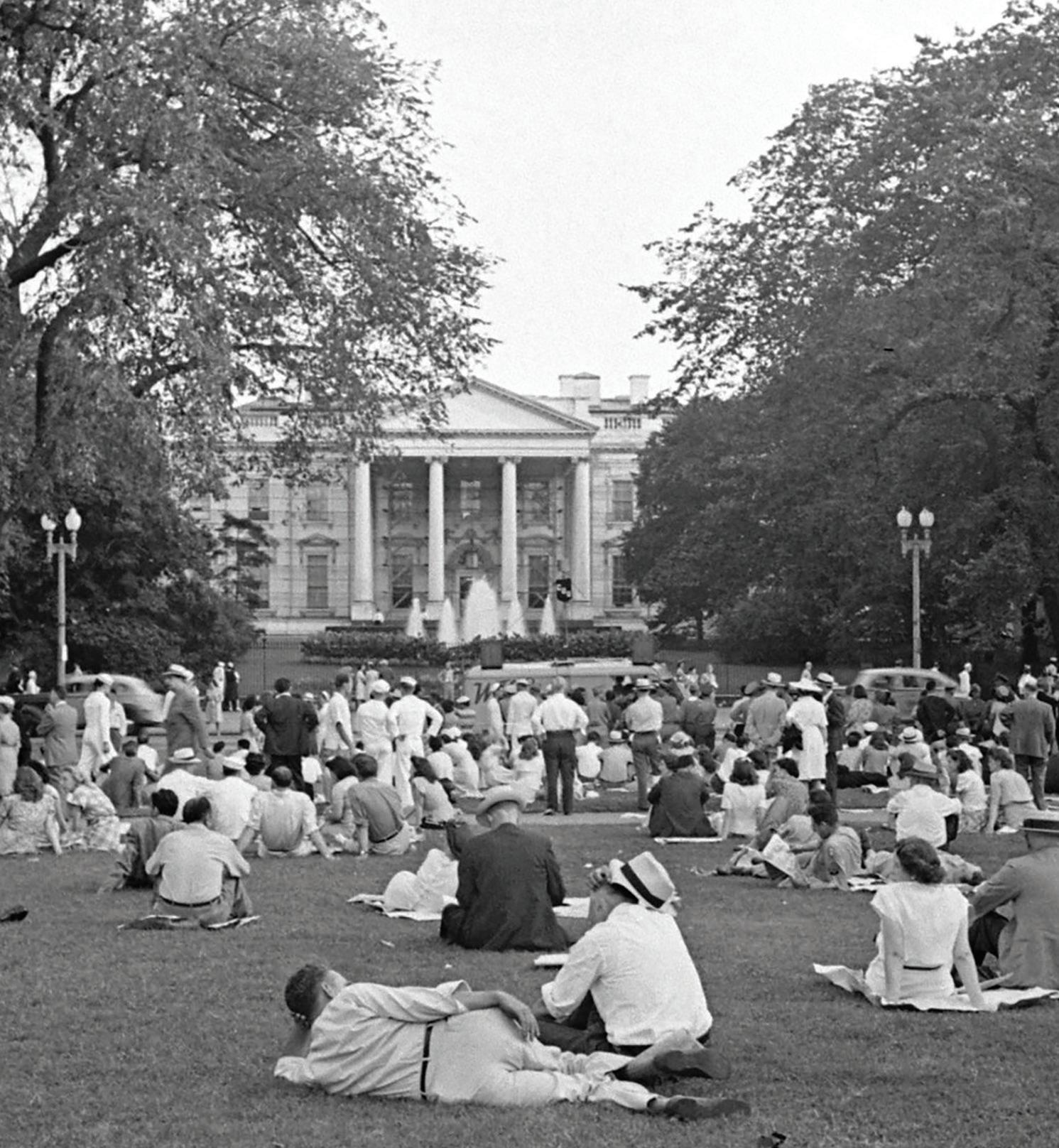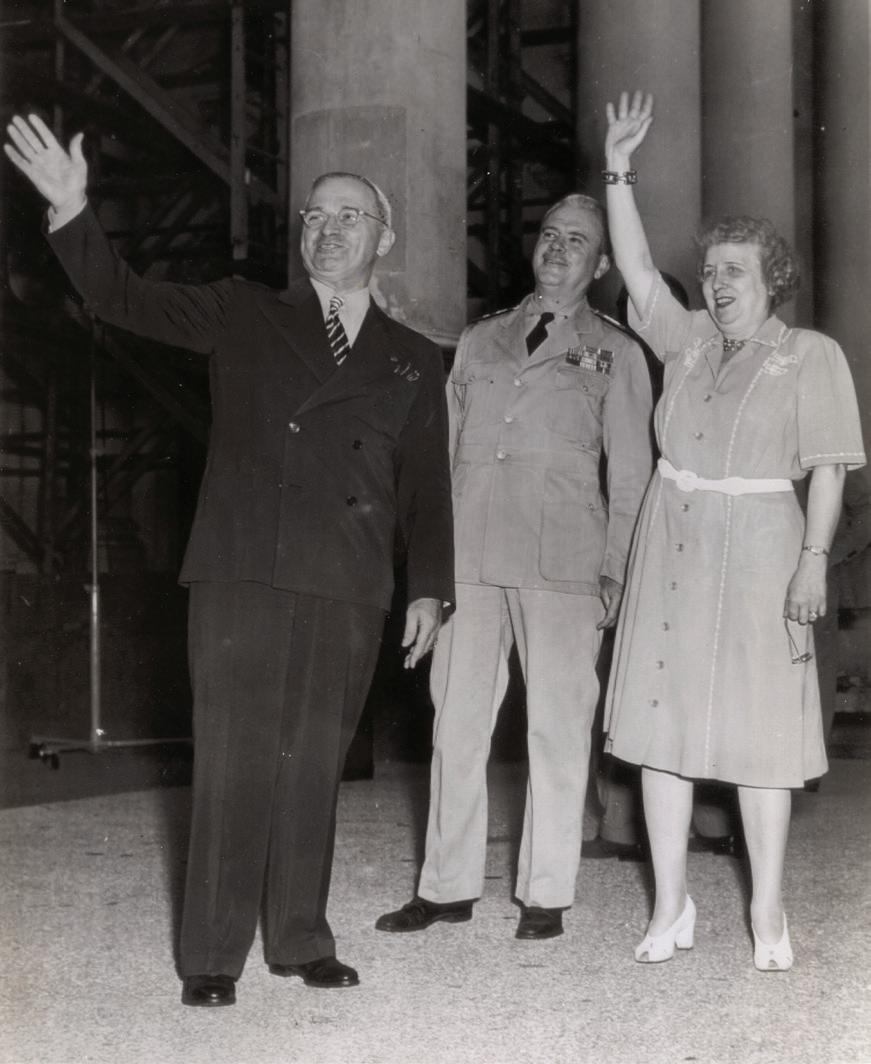Please note that the following is a digitized version of a selected article from White House History Quarterly, Issue 77, originally released in print form in 2025. Single print copies of the full issue can be purchased online at Shop.WhiteHouseHistory.org
No part of this book may be reproduced or distributed in any form or by any means, electronic or mechanical, including photocopying, recording, or by any information storage and retrieval system, without permission in writing from the publisher.
All photographs contained in this journal unless otherwise noted are copyrighted by the White House Historical Association and may not be reproduced without permission. Requests for reprint permissions should be directed to rights@whha.org. Contact books@whha.org for more information.
© 2025 White House Historical Association.
All rights reserved under international copyright conventions.
Eighty Years Ago
joyful crowds surged toward the White House on the hot and cloudy summer day, now nearly eighty years ago, when World War II finally came to an end. The nation’s attention had been steadily fixed on the White House since the U.S. entered the war on December 8, 1941, following the Japanese attack on Pearl Harbor. The war years brought suffering, loss, and sacrifice to every American, and moments of shared celebration were rare. Everything changed on August 14, 1945, when President Harry S. Truman announced the news of the Japanese surrender. The president’s short remarks, broadcast through loudspeakers set up on the North Drive of the White House and atop a WTOP van parked on Pennsylvania Avenue, drew hundreds of soldiers, sailors, and Washingtonians of all ages to the White House fence where, for a moment, they were rewarded with a wave from the president. Memories of this day would last their lifetimes and the history of the war itself would forever be a part of White House history.
drew hundreds of
With this issue, as the eightieth anniversary of V-E Day approaches on May 8, 2025, and V-J Day on August 14, 2025, the Quarterly turns to the topic of the White House during World War II. The varied articles to follow take us to the Oval Office for a glimpse of the two presidents who served during the war and one who survived to serve later, inside the White House to the Map Room, outside to the Victory Garden, across the street to the Stage Door Canteen, and part way around the world to Casablanca. We look at the White House visits of diplomats, a holocaust survivor, and a beloved war correspondent, and end with a trip to Pearl Harbor.
two presidents who served during the war and one who miraculously survived to serve later, inside the White House to the Map Room, outside to the Victory Garden, across the street to the Stage Door Canteen, and part way around the world to Casablanca. We look at the White House visits of diplomats, a holocaust survivor, a beloved war correspondent, and end with a trip to Pearl Harbor.
It is a survival story that opens the issue. Author Barbara A. Perry recounts how a famous SOS carved into the husk of a coconut in the Pacific Theater ultimately gave America its thirty-fifth president, John F. Kennedy.
It is a survival story that opens the issue. Author Barbara A. Perry recounts how a famous SOS carved into the husk of a coconut in the Pacific Theater ultimately gave America its thirty-fifth president, John F. Kennedy.
Mary Joe Binker tells the story of a wartime invitation to tea at the White House, when Ernie Pyle, one of America’s favorite war correspondents, met his biggest fan, fellow columnist, First Lady Eleanor Roosevelt.
Mary Joe Binker tells the story of a wartime invitation to tea at the White House, when Ernie Pyle, one of America’s favorite war correspondents, met his biggest fan, fellow columnist, First Lady Eleanor Roosevelt. Joel Kemelhor reminds us, however, that not all White
Joel Kemelhor reminds us, however, that not all White House visits were quite so friendly, as he recalls the diplomats who made their way to the Oval Office in the era of the war.
House visits were quite so friendly, as he recalls the diplomats who made their way to the Oval Office in the era of the war.
Jonathan Pliska explains how ten-year old Diana Hopkins came to join Americans across the nation in creating a Victory Garden to aide in the war effort. But the 20 square foot parcel where she tended radishes, carrots, beets, cabbage, and more was the only one planted on the grounds of the White House itself.
Jonathan Pliska explains how ten-year old Diana Hopkins came to join Americans across the nation in creating a Victory Garden to aide in the war effort. But the 20 square foot parcel where she tended radishes, beets, cabbage, and more was the only one planted on the grounds of the White House itself.
Jessie Kratz focuses on the signatures of President Franklin D. Roosevelt and British Prime Minister Winston Churchill, now preserved on a document in the National Archives, to reveal the story of secret strategy meeting in Casablanca, Morocco. Alan Capps explains that it was Churchill’s London War Rooms that inspire Roosevelt’s creation of the White House Map Room, where maps remain stored and displayed today. Long gone, however is the Belasco Theater on Lafayette Square, which housed the Stage Door Canteen during the war. Cindy Gueli reminds us of the shows, music, dancing, and refreshments that welcomed service members for brief interludes of rest and relaxation.
Jessie Kratz focuses on the signatures of President Franklin D. Roosevelt and British Prime Minister Winston Churchill, now preserved on a document in the National Archives, to reveal the story of secret strategy meeting in Casablanca, Morocco. Alan Capps explains that it was Churchill’s London War Rooms that inspired Roosevelt’s creation of the White House Map Room, where maps remain stored and displayed today. Long gone, however is the Belasco Theater on Lafayette Square, which housed the Stage Door Canteen during the war. Cindy Gueli reminds us of the shows, music, dancing, and refreshments that welcomed service members for brief interludes of rest and relaxation.
David Marthy presents President Franklin Roosevelt’s death from the unexpected perspective of the young West Point Cadets who heard the news as they prepared to go to war, and who would participate in his funeral at Spring Hill.
David Marthy presents President Franklin Roosevelt’s death from the unexpected perspective of the young West Point Cadets who heard the news as they prepared to go to war, and who would participate in his funeral at Spring Hill.
Randy Sowell picks up the narrative with the dramatic opening months of Harry Truman’s presidency, during which he announced the end of the war.
Randy Sowell picks up the narrative with the dramatic opening months of Harry Truman’s presidency, during which he announced the end of the war.
Christina Ewald explains how the end of the war was the beginning of a very different life for Martin Greenfield. Liberated from Buchenwald by troops under the command of General Dwight D. Eisenhower, Greenfield went on to tailor fine clothing for six presidents, including his hero, President Eisenhower.
Christina Ewald explains how the end of the war was the beginning of a very different life for Martin Greenfield. Liberated from Buchenwald by troops under the command of General Dwight D. Eisenhower, Greenfield went on to tailor fine clothing for six presidents, including his hero, President Eisenhower.
Lauren McGwin concludes the issue with a visit to the Battleship Missouri Memorial at Pearl Harbor, Hawaii, where she discovers this issue’s presidential site, the Truman Line.
Lauren McGwin concludes the issue with a visit to the Battleship Missouri Memorial at Pearl Harbor, Hawaii, where she discovers this issue’s presidential site, the Truman Line.
marcia mallet anderson editor, white house history quarterly

The White House
August 14, 1945




above and right In anticipation of news of the Japanese surrender, a WTOP van parks on Pennsylvania Avenue and the people begin to gather in Lafayette Park.
opposite, clockwise from top left Members of the White House Press Corps run from the Oval Office toward telephones to report on President Harry S. Truman’s announcement of the surrender of Japan and the end of World War II.
President and Mrs. Truman, joined by Commodore James Kimble Vardaman Jr., wave to the crowds gathered to celebrate outside the White House fence.
left celebrates the end of the war with a conga line in Lafayette Park.
The cheering crowd turns toward photographers gathered near the WTOP van following the historic announcement.




